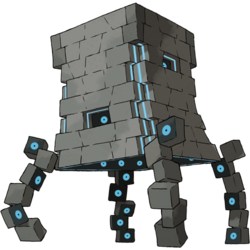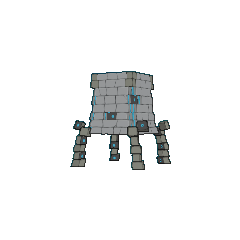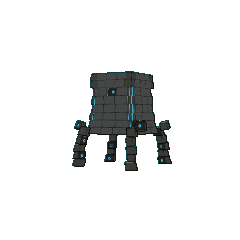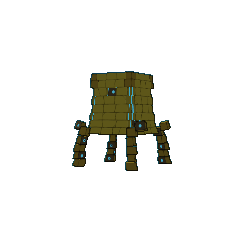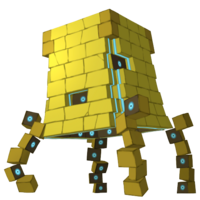Biology
Stakataka is an Ultra Beast composed of many dark gray, stone lifeforms stacked together to form a four-sided tower with a spindly leg on each corner. The stones that form the legs and the top corners are slightly darker. When at rest, its legs fit into the corners of the structure. Its lighter gray stones have glowing blue lines on their sides, which are visible along its edges and underside. Each stone square has a black underside with a circular, glowing blue eye in the center. These eyes will turn red whenever angered or fighting.[1] According to Phyco, a single Stakataka consists of almost 150 individual lifeforms. As seen in the anime, Stakataka hates having anything on top of itself and will violently try to shake the object off. However, if someone can resist the shaking and successfully ride it, then it will calm down and they'll gain Stakataka's respect.
In the anime
Major appearances
Stakataka debuted in The Long Vault Home!, where it arrived at the Pokémon School through an Ultra Wormhole around midnight. The Ultra Guardians attempted to catch it, but all of their attempts failed. It later made its way onto the construction site of a hotel being built by Viren and his henchmen. Viren mistook Stakataka for a statue stand and placed a golden statue of himself on top of it, causing it to go berserk. With Kiawe's help, Ash and Pikachu detached the statue, calming Stakataka down long enough for it to allow him to catch it in a Beast Ball. Ash later released it, allowing Stakataka to go through another Ultra Wormhole back to its home.
Minor appearances
Pokédex entries
| Episode
|
Pokémon
|
Source
|
Entry
|
| SM085
|
Stakataka
|
Rotom Pokédex
|
Stakataka, the Rampart Pokémon. A Rock and Steel type. Numerous lifeforms have apparently gathered to create a stone wall that remains motionless.
|
|
In the mangaIn the TCGGame data
Pokédex entries
| This Pokémon was unavailable prior to Generation VII.
|
| Generation VII
|
|
Alola
USUM: #392
|
|
Kanto
#—
|
| This Pokémon has no Pokédex entries in Sun, Moon, Let's Go, Pikachu! and Let's Go, Eevee!.
|
| Ultra Sun
|
It appeared from an Ultra Wormhole. Each one appears to be made up of many life-forms stacked one on top of each other.
|
| Ultra Moon
|
When stone walls started moving and attacking, the brute's true identity was this mysterious life-form, which brings to mind an Ultra Beast.
|
|
|
|
|
|
|
Game locations
| This Pokémon was unavailable prior to Generation VII.
|
|
|
|
|
|
|
Stats
Base stats
| Stat
|
Range
|
| At Lv. 50
|
At Lv. 100
|
61
|
|
121 - 168
|
232 - 326
|
131
|
|
122 - 201
|
240 - 397
|
211
|
|
194 - 289
|
384 - 573
|
53
|
|
52 - 115
|
99 - 225
|
101
|
|
95 - 168
|
186 - 331
|
13
|
|
16 - 71
|
27 - 137
|
Total: 570
|
Other Pokémon with this total
|
- Minimum stats are calculated with 0 EVs, IVs of 0, and (if applicable) a hindering nature.
- Maximum stats are calculated with 252 EVs, IVs of 31, and (if applicable) a helpful nature.
|
Type effectiveness
| Under normal battle conditions in Generation IX, this Pokémon is:
|
|
|
|
|
|
|
|
|
|
|
|
|
Learnset
Stakataka is available in Sword and Shield Version 1.3.0+.
| Generation VIII
|
| Other generations:
|
| VII - IX
|
|
|
|
|
- Bold indicates a move that gets STAB when used by Stakataka
- Italic indicates a move that gets STAB only when used by an Evolution of Stakataka
|
| Generation VIII
|
| Other generations:
|
| VII - IX
|
|
|
|
|
- Bold indicates a move that gets STAB when used by Stakataka
- Italic indicates a move that gets STAB only when used by an Evolution of Stakataka
|
| Generation VIII
|
| Other generations:
|
| VII - IX
|
|
|
|
|
- Moves marked with an asterisk (*) must be chain bred onto Stakataka in Generation VIII
- Moves marked with a double dagger (‡) can only be bred from a Pokémon who learned the move in an earlier generation.
- Moves marked with a superscript game abbreviation can only be bred onto Stakataka in that game.
- Bold indicates a move that gets STAB when used by Stakataka
- Italic indicates a move that gets STAB only when used by an Evolution of Stakataka
|
| Generation VIII
|
| Other generations:
|
| VII - IX
|
|
|
|
|
- Bold indicates a move that gets STAB when used by Stakataka
- Italic indicates a move that gets STAB only when used by an Evolution of Stakataka
- Click on the generation numbers at the top to see Move Tutor moves from other generations
|
By transfer from another generation
|
|
|
|
- Transferred Pokémon only retain these moves in Pokémon Sword and Shield
- A striped background indicates a generation in which the move can only be obtained via event or as a special move
- Bold indicates a move that gets STAB when used by Stakataka
- Italic indicates a move that gets STAB only when used by an Evolution of Stakataka
- × indicates a move that cannot be used in Sword and Shield
|
Side game data
Pokémon GO
| File:GO805.png
|
Base HP: 156
|
Base Attack: 213
|
Base Defense: 298
|
| Egg Distance: N/A
|
Buddy Distance: 20 km
|
Evolution Requirement: N/A
|
| Fast Attacks:
|
| Charged Attacks:
|
|
|
Evolution data
Sprites
| This Pokémon was unavailable prior to Generation VII.
|
|
|
|
|
| This Pokémon is unavailable in Generation IX.
|
|
|
Trivia
- Stakataka could be a counterpart to fellow Ultra Beast Blacephalon. Both have high Attack stats and the same base stat total, but Stakataka has one of the lowest Speed stats and has a high Defense and a decent Special Defense, while Blacephalon is fast and has a high Special Attack. Additionally, both appear in Poni Grove at the same point in the story, with Stakataka appearing in Ultra Moon and Blacephalon appearing in Ultra Sun.
- Stakataka is the heaviest Rock-type Pokémon.
- Stakataka's Pokédex height seemingly refers to its size while at rest, as seen in Pokémon Refresh and the anime. When comparing sizes in Pokémon HOME, Stakataka standing on its legs is shown to be nearly twice as tall as Guzzlord, which is also listed as having a height of 18'01" (5.5 m).
Origin
Stakataka resembles a castle tower. It may take inspiration from Mokumokuren, a species of yōkai known for living in walls and is distinctly identified by its myriad of eyes; and Nurikabe, a yōkai known for blocking the way of travelers in the guise of a wall.
Stakataka could also be inspired by the architecture of the Talaiotic culture, a culture that inhabited the Gymnesian Islands in Spain and was characterized by its architecture of white bricks in the shape of a pyramid. It could also take inspiration from Naveta d'Es Tudons, a collective tomb in Menorca where several bodies and jewels were found (which explains that each brick is an independent way of life; Stakataka being composed of individual life-forms would be echoing this).
Stakataka may also take inspiration from colonial organisms, with each brick functioning like a zooid. Being an Ultra Beast, it may also reference the science-fiction concept of aliens linked together in a group mind.
Name origin
Stakataka may be a combination of stack and attack.
Tundetunde may be derived from a repetition of 積んで tsunde (stacked).
In other languagesRelated articlesReferencesExternal links

|
This Pokémon article is part of Project Pokédex, a Bulbapedia project that aims to write comprehensive articles on each Pokémon species, as well as Pokémon groups and forms.
|


 For other sprites and images, please see Stakataka images on the Bulbagarden Archives.
For other sprites and images, please see Stakataka images on the Bulbagarden Archives.
